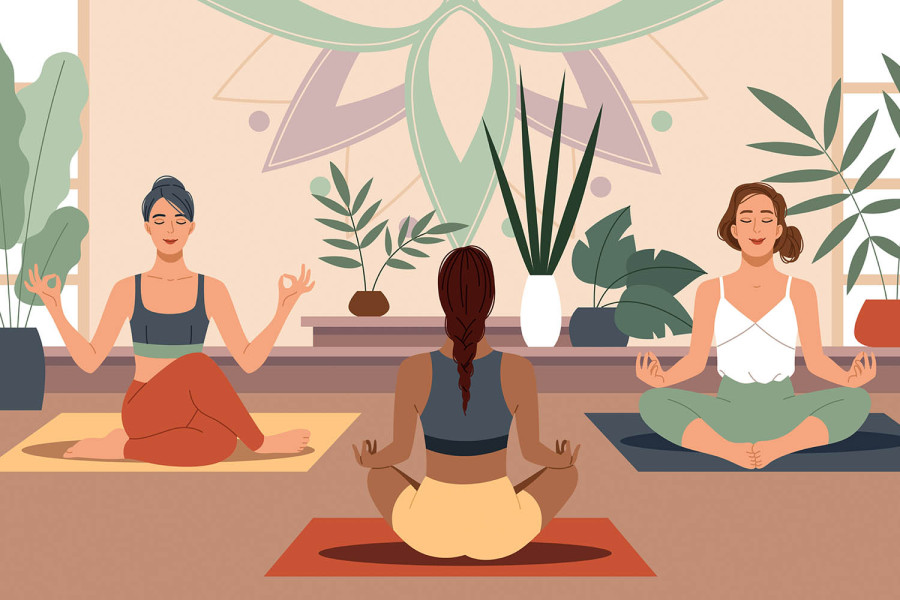Culture & Lifestyle
Managing pain through meditation
Ancient teachings and contemporary scientific studies show that mindfulness and meditation can alleviate pain, reduce stress, and enhance overall well-being.
Badri Prakash Ojha
Dr Ainslie Meares, a psychiatrist from Melbourne, Australia, was interested in meditation and visited Shivapuri Baba in Dhruvasthali, Kathmandu, in 1961. Dr Meares asked Baba how he managed pain; Baba said, “I experience pain, but it does not hurt.”
Pain without hurt! How could this be? And could it be taught as a genuine and practical way of alleviating pain? Again, Dr Meares asked. Baba answered: “To experience the truth, you must learn to meditate.”
Dr Meares spent three days with Baba, learning meditation before returning to Melbourne to experiment on himself. After three years of practice, he underwent major dental surgery without anaesthetic or pain, convinced of meditation's medical significance. He believed it reduced pain by altering how the brain and body perceive it through psychological and physiological mechanisms. Researchers explain that pain begins with sensory neurons called nociceptors, found in the skin, muscles, joints, and organs. These detect harmful stimuli like heat, pressure, or chemicals that could cause damage.
Meanwhile, in 1970, Dr Herbert Benson, a renowned Harvard professor, pioneered research on the relaxation response, a physiological state that can be induced through meditation and other relaxation techniques.
Two doctors made significant contributions to mind-body medicine. Dr Jon Kabat-Zinn, an American professor at MIT, conducted experiments and wrote ‘Full Catastrophe Living’ (1990), which Vietnamese Buddhist monk Thich Nhat Hanh reviewed. The book explains how meditation alters brain activity in areas linked to pain perception, including the primary somatosensory cortex, insula, anterior cingulate cortex, and prefrontal cortex. These regions are responsible for pain's sensory, emotional, and cognitive aspects. Hanh was key in introducing mindfulness and Zen Buddhism to the West.
Meditation reduces the activation of pain-related brain regions, leading to a lower perception of its intensity. It helps separate the sensory experience of pain from the emotional response. While the pain remains, the emotional suffering and distress are lessened due to reduced activity in the anterior cingulate cortex, which governs the emotional aspect of pain.
Altered Perception of Pain
The brain's ability to adapt, known as neuroplasticity, allows meditation to bring long-term changes to areas involved in pain perception, such as the prefrontal cortex (attention and self-regulation) and the anterior cingulate cortex (emotional aspect of pain). These changes can reduce the perception of pain. Mindfulness meditation promotes non-judgmental awareness of the present, including pain. By observing pain without attaching negative emotions, individuals can alter their perception, making it less distressing.
Meditation also helps to decouple the sensory experience of pain from the emotional suffering it usually triggers. While the pain sensation might still be present, the associated emotional distress is reduced, leading to a lower overall pain experience.
Reduction in Stress and Anxiety
Meditation lowers stress hormones like cortisol and adrenaline, which can intensify pain. Reduced stress helps the body relax, easing muscle tension and decreasing pain sensitivity. Anxiety and fear often worsen pain, but meditation calms the mind, reducing both anxiety and the anticipation of pain, leading to a lower perception of pain.
Release of Endorphins
Meditation can stimulate the release of endorphins, the body's natural painkillers. Endorphins interact with the brain's pain receptors to reduce the perception of pain, similar to the effects of opioids but without the side effects.
Enhanced Pain Tolerance
Regular meditation is linked to increased pain tolerance, allowing individuals to endure pain with less distress. Consistent practice leads to desensitisation to pain stimuli, meaning the pain is still present, but the person reacts less intensely.
Focus and Distraction
Meditation teaches individuals to shift focus away from pain, directing attention to other sensations or the breath, which reduces pain intensity. It also helps reframe pain as a temporary sensation rather than something overwhelming or threatening, making the experience more manageable and less distressing.
Regulation of the Nervous System
Meditation activates the parasympathetic nervous system, promoting relaxation and reducing the body’s stress response, which helps lower the pain response. Chronic pain is often linked to inflammation, and meditation has been shown to reduce inflammatory markers, helping alleviate pain in conditions like arthritis and other inflammatory diseases.
Long-Term Brain Changes
Regular meditation induces structural brain changes through neuroplasticity, including increased grey matter in areas linked to pain regulation and emotional control, fostering a more resilient response to pain. It also reduces activity in the Default Mode Network (DMN), which is active during rest and linked to rumination. By lowering DMN activity, meditation helps reduce focus on pain, lessening mental suffering.
This is how we can practice MBSR
In a Mindfulness-Based Stress Reduction session, you practice mindfulness meditation, a simple yet powerful way to reduce stress, manage pain, and cultivate a sense of well-being. The exercises are designed to help you develop mindfulness—the practice of being fully present in the moment, with a nonjudgmental awareness of your thoughts, feelings, and bodily sensations.
Body Scan Meditation (15-20 minutes)
Begin by finding a comfortable position, either sitting or lying down. If it feels right, close your eyes or simply soften your gaze. Take a few deep breaths, inhaling deeply through your nose and exhaling slowly through your mouth, allowing your body to relax with each breath.
Now, shift your focus to your body. Start at the top of your head and gradually move down to your toes. Notice any sensations, tension, or discomfort along the way. There’s no need to alter anything—just observe with curiosity, free of judgment.
Head: Focus on the top of your head. Notice any sensations on your scalp, forehead, or around your eyes. Acknowledge any tension without trying to change it.
Neck and Shoulders: Move your awareness to your neck and shoulders. Notice any tightness or discomfort. Allow your shoulders to drop and relax as you breathe deeply.
Arms and Hands: Shift your attention to your arms, from upper arms to forearms, wrists, and fingers. Observe sensations like warmth, coolness, or tingling.
Chest and Abdomen: Focus on your chest and abdomen. Notice the rise and fall of your breath. Observe any sensations of tightness, relaxation, or movement in your stomach.
Back: Bring awareness to your back, from the upper back and shoulder blades to the lower back. Notice how your back feels as it supports you.
Legs: Move your attention to your legs, from thighs to knees, calves, and ankles. Observe any sensations of heaviness, lightness, warmth, or coolness.
Feet and Toes: Finally, focus on your feet and toes. Notice how they feel against the floor or their resting surface.
Take a few deep breaths. When you’re ready, gently bring your awareness back to the room, wiggle your fingers and toes to reawaken your body, and slowly open your eyes.
Mindful Breathing (5-10 minutes)
Focus on your breath while sitting comfortably with a straight but relaxed back. Close your eyes or keep them slightly open with a soft gaze. Notice the natural rhythm of your breath without trying to change it. Feel the air entering your nostrils, filling your lungs, and flowing out again. If your mind wanders, gently guide it back to your breath. You might silently say “inhale” and “exhale” to help maintain focus. Observe your breath briefly, noting how it feels and how your body moves.
When ready, take a deep breath, exhale slowly, open your eyes, and return your awareness to the room.
Mindful Movement (10-15 minutes)
With these gentle stretches, let’s engage in mindful movement to connect with your body and release tension.
Neck Rolls: Slowly roll your head from side to side, noticing sensations in your neck. Move gently within a comfortable range.
Shoulder Rolls: Lift your shoulders towards your ears, then roll them back and down. Repeat a few times, syncing with your breath.
Arm Stretches: Extend your arms to the sides, then lift them above your head as you inhale. Exhale as you bring them down, feeling the stretch in your shoulders and arms.
Forward Bend: Stand and gently bend forward at the hips, letting your arms hang towards the floor. Relax your head and neck. If standing is uncomfortable, do this seated.
Seated Twist: Place your right hand on your left knee. Gently twist your torso to the left, using your hand for support. Hold for a few breaths, then switch sides.
Move slowly and mindfully, paying attention to the sensations in your body and respecting its limits.
Loving-Kindness Meditation (5-10 minutes)
Finally, we will end the session with a Loving-Kindness Meditation. This practice involves silently sending kind and compassionate thoughts to yourself and others.
Start by bringing to mind a positive image of yourself. Silently repeat the following phrases, or choose words that resonate with you:
May I be happy.
May I be healthy.
May I be safe.
May I live with ease.
After a few moments, expand your focus to include others—your loved ones, friends, and even people you may find challenging. Repeat the phrases for each person:
May you be happy.
May you be healthy.
May you be safe.
May you live with ease.
If your mind wanders, gently bring it back to the phrases and the people you’re thinking of. Feel the warmth and kindness in your heart as you offer these wishes.
When you are ready, take a deep breath and open your eyes. Notice how you feel after extending compassion to yourself and others.
Ojha is a meditation teacher with a PhD in communication. He can be reached at [email protected]




 10.12°C Kathmandu
10.12°C Kathmandu















